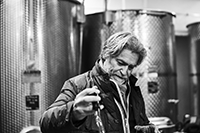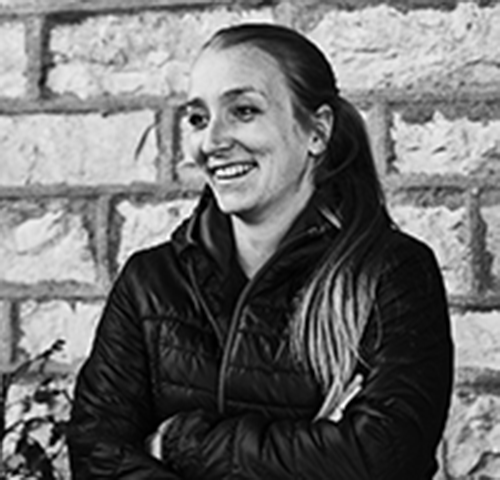Domaine de l'Arlot
.png)
This beautiful domaine in Premeaux-Prissey was bought by insurers Axa Millésimes in 1987, whose other estates include Quinta do Noval in Portugal and Château Pichon Baron in Bordeaux. Axa’s man at the top, Christian Seely, not only had the good judgement to appoint Géraldine Godot to the post of régisseuse in 2015, but also had the good sense to let her get on with her job, allowing her free reign to make the style of wines she loves.
She has thrived here, and her hard work is paying dividends for the estate’s remarkable holdings, including two monopoles, Clos de l’Arlot and Clos des Forêts. Her style brings finesse and delicacy to the reds. These 2022s show flare and confidence.
Some wines on allocation
Domaine Faiveley
.png)
Domaine Faiveley is one of the most prestigious names of Nuits-Saint-Georges. It was founded in 1825 and is still under family control, today it is run by seventh generation brother and sister, Erwan and Eve Faiveley. Their modern story is far more about their domaine holdings than their négociant past.
Their magnificent vineyards stretch across the length of Burgundy, and are particularly rich in Côte de Nuits grands crus. All the wines are vinified in their magnificent cellars in Nuits, which are more like a cathedral to wine than a winery. Faiveley may be big, but they’re also brilliant.
Some wines on allocation
Domaine Bertrand et Axelle Machard de Gramont
Axelle had joined her father, Bertrand, in 2005, with what she now admits were some fairly rose-tinted ambitions for a bucolic organic revamping of the family’s Nuits-St-Georges domaine. She has stayed true to her ambitions (the domaine was certified organic in 2014), but she quickly came to realise that organic farming was hard work. Happily, the challenges have only made her grow as a vigneronne. She moved from cramped cellars in the centre of Nuits up to the remote Hautes-Côtes village of Curtil-Vergy, and is now in sole charge of the 6-hectare domaine, from which she makes a beautiful array of Nuits-St-Georges reds and a particularly mouthwatering Aligoté from a parcel of vines up near the isolated cellar.
There are no flashy vineyards in the portfolio, but the wines are worthy of serious attention for anyone who likes Pinot made with a light but experienced touch, where whole-bunch, new oak, and other winemaking fashions are not toyed with. Axelle doesn’t release her wine en primeur, so we are currently selling her 2020s. They have the vintage’s natural character: rich, robust, and muscular, and could do with some time to come around.
Late release: 2020 released in Summer 2023
Marchand-Tawse

Québécois Pascal Marchand first came to Burgundy in 1983 first working at Domaine Comte Armand and Domaine de la Vougerie, before establishing his own business. In 2006 he founded négociant Marchand-Tawse in collaboration with Ontario-born businessman, and Burgundy nut, Moray Tawse.
In 2012 they bought the nine-hectare Gevrey-Chambertin estates, Domaine Maume. From 2016 onwards all the winemaking from both branches of the business has taken place in the company’s main cellars in Nuits-St-Georges, and from the 2021 vintage inwards, all the cuvées have been brought under the Marchand-Tawse label, however the domaine-owned wines are labelled with the extra signification of “Vignes de la famille Tawse”. Collectors who have followed the Gevrey estate from early on can rest assured its integrity remains intact. The wines of both domaine and négociant share much in common, not least their fabulous quality which repeatedly earns them plaudits from the critics, so it makes sense they now all fall under the same label.
The domaine wines continue to be made by talented Englishman Mark Fincham, while Thomas Dinel ushers the impressive négociants wines through the cellar. Mark says unlike 2021, which he found traumatic, 2022s just came to him. And the wines show an effortless class.
Some wines on allocation
Domaine Jean-Marc Millot

This domaine has witnessed one of the most successful generation shifts we’ve come across, with Jean-Marc’s talented daughter Alix Millot stepping up to the plate. The cellars might be based in Nuits-St-Georges, but most of their wines come from the appellations just beyond, including the truly excellent Côtes de Nuits-Villages.
Alix has also inherited some beautiful vineyards in and around Vosne and Flagey-Echézeaux from her mother, which have been a part of the domaine since 1987, including an exceptional parcel of premier cru Les Suchots, as well as three grands crus (Echézeaux, Grands-Echézeaux, and Clos de Vougeot). She has been in charge of winemaking since 2016, and the wines have taken on an extra precision and definition in her hands. Demand, quite deservedly, increases every year as Alix earns a name as one of the most exciting young winemakers in the region. The wines are muscular and handsome, with the vintage’s fluent terroir expression on display. Her sensible pricing strategy in 2022 should be applauded.
Some wines on allocation
Domaine Michèle et Patrice Rion
Michèle and Patrice established their domaine in 2000, having split from Patrice’s father’s domaine - Domaine Daniel Rion. They are now joined by their son, Maxime, who has helped navigate the choppy waters of inheriting some family vineyards back, seeing the domaine grow by two and a half hectares in 2022, with the welcome addition of more Bourgogne and Vosne-Romanée parcels. They used the négociant label, Patrice Rion, in the transitioning years where they were obliged to buy fruit from family vineyards, but from 2022 onwards almost everything is domaine, with the exception of the sensational Nuits and Chambolle village wines, where a small amount of négociant fruit supplements the domaine’s vineyards.
The past few vintages have seen the quality explode here, and we feel extremely lucky to have taken a position when we did (we first bought the 2020 vintage). Maxime is making some very serious wines, with density and precision, and lots of soul. It’s hard to describe it as still under-the-radar, as the secret is well and truly out now. So make haste.
Aurélien Verdet
.png)
Aurélien’s cellars are tucked up in the Hautes-Côtes de Nuits in the quiet village of Arcenant. He keeps a fairly low profile, spending most of his time in the vineyards, which are farmed organically. In fact, his vineyards in the Hautes-Côtes have been organically farmed since 1971 by his father before him, who started down the organic path a good ten years before Aurélien was born. These must be some of the longest continually organically-farmed vines in the whole of Burgundy.
Aurélien took over in 2005, and since then his winemaking has evolved, increasing his use of whole-bunch, until he has reached 100% across the range. The wines are worth seeking out for fans of this style of Burgundy: sweetly spiced, with soft red fruit tones. His domaine-owned Hautes-Côtes is a great example of how this elevated, slightly cooler region is excelling in recent years. Since 2009 he has held négociant contracts with vineyards across the Côte de Nuits, and he applies his whole-bunch magic to these with the same flare as his Hautes-Côtes.